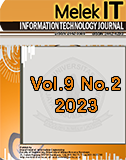Abstrak
Kepuasan mahasiswa dalam menggunakan Learning Management System (LMS) menjadi salah satu faktor penentu prestasi tujuan pembelajaran yang berani di perguruan tinggi. Penelitian ini bertujuan untuk menguji kepuasan dan kegunaan LMS untuk siswa dalam pembelajaran berani menggunakan beberapa variabel pada End User Computing Satisfaction (EUCS) dan Task Kesesuaian Teknologi (TTF). Hubungan antar variabel pada EUCS dan TTF diuji dengan menggunakan metode Structural Model Persamaan (SEM) berdasarkan 184 data responden yang diperoleh dari mahasiswa pengguna LMS Moodle di sebuah universitas di Jakarta. Hasil penelitian mengungkapkan bahwa variabel karakteristik tugas dan karakteristik teknologi berdampak signifikan terhadap tugas TTF dan EUCS, dan TTF berdampak positif terhadap EUCS. Hasil penelitian memberikan rekomendasi bahwa resolusi teknologi LMS dan kemudahan penggunaan LMS menjadi faktor dominan mempengaruhi kepuasan siswa dalam menggunakan LMS.
Referensi
Ahmed, Z., & Kader, A. (2017). mBanking adoption; Exploratory factor analysis; UTAUT;TTF; Bangladesh. http://www.icommercecentral.com
Ambra, J. D. , Wilson, C. S., & Akter, S. (2013).Application of the task-technology fit model to-structure and evaluate Application of the tasktechnology fit model to structure and evaluate the adoption of e-books by academics. Recommended Citation. https://ro.uow.edu.au/ commpapers/
Chin, W. W. (1998). The Partial Least Squares Approach for Structural Equation Modeling.
Chin, W. W., & Dibbern, J. (2010). An Introduction to a Permutation Based Procedure for Multi-Group PLS Analysis: Results of Tests of Differences on Simulated Data and a Cross-Cultural Analysis of the Sourcing of Information
System Services Between Germany and the USA. In Handbook of Partial Least Squares (pp. 171–193). Springer Berlin Heidelberg.https://doi.org/10.1007/978-3-540-32827-8_8
Coates, H., James, R., & Baldwin, G. (2005). A Critical Examination Of The Effects Of Learning Management Systems On University Teaching And Learning. Tertiary Education and Management 2005 11:1, 11(1), 19–36. https://doi.org/10.1007/ S11233-004-3567-9
Cronbach, L. J. (1951). Coefficient Alpha and The Internal Structure of Tests.
Dishaw, M. T., Strong, D. M., & Bandy, D. B.(2002). 2002-Eighth Americas Conference on Information Systems. https://www.researchgate.net/publication/228781418
Doll, W. J., & Torkzadeh, G. (1988). The Measurement of End-User Computing Satisfaction. MIS Quarterly, 12(2), 259.https://doi.org/10.2307/ 248851
Fornell, C., & Larcker, D. F. (1981). Evaluating Structural Equation Models with Unobservable Variables and Measurement Error. In Source:Journal of Marketing Research (Vol. 18, Issue 1).
Goodhue, D. L., & Thompson, R. L. (1995). Tasktechnology fit and individual performance. MIS Quarterly: Management Information Systems, 19(2), 213–233. https://doi.org/10.2307/249689
Ha J.H, S. Y. (2014). An Analysis on the Relation of Elementary Students’ VARK Styles and Scientific Communication Skills. Journal of Korean Elementary Science Education, 33(4), 724–735.
Hair JR. J.F, Anderson R.E, Tatham R.L, & Black W.C. (2009). Multivariate Data Analysis Fifth Edition. Prentice Hall, Inc.
Henseler, J., Ringle, C. M., & Sinkovics, R. R. (2009). The use of partial least squares path modeling in international marketing. Advances in International Marketing, 20, 277–319. https://doi.org/10.1108/S1474-7979(2009)0000020014
Klarner, P., Sarstedt, M., Hoeck, M., & Ringle, C.M. (2013). Disentangling the Effects of Team Competences, Team Adaptability, and Client Communication on the Performance of Management Consulting Teams. Long Range Planning, 46(3), 258–286. https://doi.org/10.1016/J.LRP.2013.03.001
McGill, T. J., & Klobas, J. E. (2009). A task–technology fit view of learning management system impact. Computers & Education, 52(2), 496–508. https://doi.org/10.1016/J.COMPEDU.2008.10.002
Nasser, R., Cherif, M., & Romanowski, M. (2011). Factors that Impact Student Usage of the Learning Management System in Qatari Schools Nasser. In Cherif and Romanowski (Vol. 12, Issue 6).
Oliveira, T., Faria, M., Thomas, M. A., & Popovi,A. (2014). Extending the understanding of mobile banking adoption: When UTAUT meets TTF and ITM. International Journal of Information Management, 34(5), 689–703. https://doi.org/10.1016/j.ijinfomgt.2014.06.004

Artikel ini berlisensiCreative Commons Attribution-ShareAlike 4.0 International License.
Hak Cipta (c) 2024 Melek IT : Information Technology Journal

